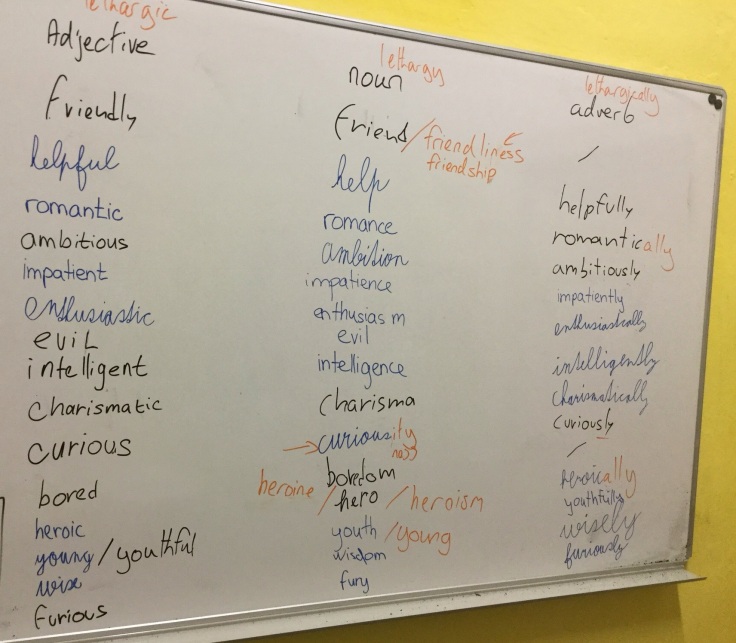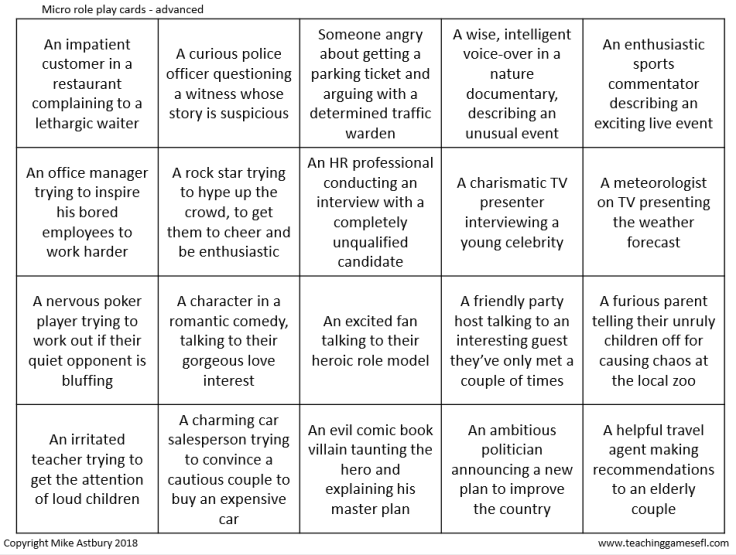This speaking activity is designed for upper intermediate and advanced students. You can find a version for lower levels by clicking here
This game is a fun and memorable way to practice grammatical structures, and in the example we’re looking at linking expressions.
Preparation
You will need to print and cut up one copy of the game cards for each group of 3 or 4 students. You can download the cards by clicking here
Next write some phrases in the target language on the board.
In this example we’re practising linking expressions. With this game I’m trying to encourage my students to give longer and more varied answers when speaking, and I hope that improving their use of linking phrases will help.
So, my board looks like this:
 Give a set of cards to each group of 3 or 4 students. I recommend smaller groups so that students get enough chances to speak.
Give a set of cards to each group of 3 or 4 students. I recommend smaller groups so that students get enough chances to speak.
Each student takes 4 cards, and checks their understanding of what’s written on them. They think about what they would say if they were in that situation.
How to play
Students take it in turns to speak. On their turn the student chooses one of their cards and speaks, acting like the person on their card. They must use at least one of the phrases on the board when they speak. The other students listen to the speaker in silence.
When the speaker has finished, the other students have to guess what the instructions on the card might be. They should try to be as specific as possible, but they shouldn’t spend too long guessing before moving on to the next speaker.
Here’s a quick example: The student looks at their cards and picks one. They also decide which phrase on the board to use, in this case, as soon as.

The student says: “The service here is terrible! I’ve been waiting to order for over thirty minutes and you’ve been extremely rude. I’d like to speak to your manager, and as soon as I do, you’ll be fired!”
The other students try to guess what the situation could be. One thinks it’s a customer in a shop, but another guesses it’s in a restaurant, because you have to wait to order at a restaurant.
At the end of their turn, when a student has finished speaking, they should discard their card and draw a new one, so that each player always has 4 cards to choose from.
Students continue to take turns until they’ve ran out of cards, or they’ve thoroughly practised the language structures on the board. You may want to interrupt the game half-way through for language input or error correction if you think your students would benefit.
Mingle
You can add a mingle after the game to give students a chance to recycle the language: While students are playing the game, ask them to keep any cards that they use. Then, after the game, ask all of your students to stand up and find new partners (someone who wasn’t in their group).
Students take it in turns to repeat what they said before, and their new partner guesses what’s on the card. Repeat this a few times with new partners. This is an excellent way for students to practice the language, and it also gives them a chance to improve on what they’d said during the first round of the game.
Finally
For another post game stage, I used these cards as the basis of a word formation activity with a CAE class. I asked students to look through the cards and pick out adjectives and convert them into nouns and adjectives. I handed out pens to each group and they worked together to complete the table below:

I think this game is quite adaptable and you could practice all sorts of language structures and vocabulary with different prompts on the board. I think it’s worth making your own cards if you have time. You could come up with a variety of simple situations to fit different topics.
Thanks for reading!
There are lots more games on the site. You can start by checking out the front page – www.teachinggamesefl.com
You can follow the site by clicking the box below the comments, find me on Facebook and follow me on Twitter.


April 5, 2018 at 12:11 pm
A very engaging and interesting game
LikeLike
April 5, 2018 at 12:20 pm
Micro role play is worthy for building and framing sentences with conjunctions as well as to get introduced with live English situations which help learners to boost his/her confidence level at real life encounter.
LikeLiked by 1 person
May 7, 2018 at 10:13 am
Hi Mike,
Just to let you know that we’ve shortlisted this blog post for this month’s TeachingEnglish blog award and I’ll be putting up a post about it on tomorrow’s TeachingEnglish Facebook page http://www.facebook.com/TeachingEnglish.BritishCouncil, if you’d like to check there for comments.
Best,
Ann
LikeLiked by 1 person
May 7, 2018 at 1:13 pm
Thanks Ann!
LikeLike